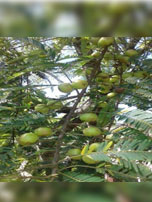SHAHEED KARTAR SINGH SARABHA AYURVEDIC MEDICAL COLLEGE & HOSPITAL
Affiliated to Guru Ravidas Ayurved University, Hoshiarpur Punjab
Affiliated to Guru Ravidas Ayurved University, Hoshiarpur Punjab

Botanical Name: Emblica officinalis Gaertn.
Family: Euphorbiaceae
Introduction:
Names in different Indian languages :
English : Emblic,Indian gooseberry.
Hindi : Amla,amlika,amalak
Kannada : Nellka
Malayalam : Nelli
Sanskrit : Amalaki,dhatri
Tamil : Nelli
Telugu : Usirikaya,amalakamu
Unani : Aamalaa, Amlaj
Synonyms :
Aaamalaka, Dhaatri, Kaayasthaa, Amoghaa, Amritaphala, Amla, Aaamalaa, Dhaatriphala, Vayasyaa, Vrshya, Shiva, Hattha,Phyllanthus emblica Linn
Classification according to Charaka, Susrutha & Vagbhata :
Charaka : Jvaraghna, Kãsaghna, Virecanopaga, Kusthaghna, Vayahsthapana
Susrutha : Amalakyãdi, Parüsakãdi, Triphala
Vagbhata : Parüsakãdi
Varieties & adulterants – (CV – controversy, AD – adulterants) :
1. Krishna (NA5)
2. Amrit (NA6)
3. Neelam (NA7)
4. Kanchan
5. Amalaki – Flacourtia jangomos [CV]
6. Pracinamalakam – F. catapharacta (different from amalaki) [CV]
Morphology :
It is a large deciduous tree with greenish-grey or red bark, peeling off in scales.
Leaves – compound, subsessile, pinnate, distichously close-set, oblong, obtuse.
Flowers – Unisexual, densely fascicled along the branchlets, greenish yellowish; males numerous on slender pedicles females sub sessile,
Fruit – berry, fleshy, depressed globose succulent, yellow or pink when ripe, obscurely 6-lobed, vertical furrows enclosing 6 trigonous seeds in 2 seeded 3 crustaceous cocci.
(flowers in April.-May )
Distribution & Habitat :
wild/cultivated throughout tropical India.
Chemical constituents :
Good source of vitamin C and minerals.
Root– gallagic acid, lupeol, oleanolic aldehyde
Bark- leucodelPhinklm, procyanidin, tannin etc.
Fruit- Vit. C, phyllemblin linolic acid, indole acetic acid and ayxubsm rigaloylglucose terchebin, corilagin, ellagic acid, phyllemblic acid & salts.
Properties :
Rasa – Amla pradhana, Pañca rasa (except Lavana)
Guna – guru
Virya- sita
Vipãka -Madhura
Karma : Tridosa hara, Vayahsthãpana, Rasãyana, Caksusya, Virya.
laxative, diuretic, antianaemic, anabolic, antiemetic, bechic, astringent, antihaemorrhagic, antidiarrhoeal,diuretic, antidiabetic, carminative, antioxidant.
Indication :
Prameha, Rakta pitta, krimi, kasa, Netra roga, Kustha, Arsas, Soma roga, Pradara, Mutrakrcchra, süla.
Ulcerative stomatitis, diabetes, gonorrhoea, jaundice, diarrhoea, myalgia, dysentry, peptic ulcer, erysipelas, inflamation, anaemia, emaciation, greyness of hair.
Part used :
Fruit pulp/Fruit.
Dosage :
Fresh juice 25-50 ml; Powder 6-8 g.
External uses :
Paste is applied locally in burning, headache due to pitta, retention of urine. Juice is used in eye disorders. Fruits are kept overnight in water and eyes are washed with this water in the morning. Hair wash by amala is done in baldness and grey hair. Toothache is relieved by chewing fruit skin. Leaf juice is used as eye drops in eye disorders.
Internal uses :
Nervous system Strengthens bone marrow and any weakness of sense organs.
Digestive system : It acts in loss of taste & appetite, anorexia, constipation, liver disorders, peptic diseases ascites and piles through its properties of digestion, laxation and rasayan. Its juice is given in haematemesis and epitasis. A paste of chandan + arnlaki is best in pittaj vomiting. Leaf juice useful in haemorrhagic dysentery.
Circulatory system : Useful in heart diseases. haemorrhagic diseases. Loha bhasma + amalaki , leaves best in anaemia
Respiratory system : Used in diseases like cough, asthma, tuberculosis etc. being a rejuvenating agent. Amlaki is a good brain tonic.
Reproductive system : It is useful in spermatorrhoea, menorrhagia, uterine debility.
Urinary system : Fresh amla juice is used in dysuria and prameha.
Skin : In skin diseases and erysipelas, ii is given internally for longer period.
Temperature : Useful in chronic fever, thirst, burning sensation etc.
Satmikaran : Rasayan, rejuvenator.
Important Yogas or Formulations :
Cyavanaprãsa; Dhatriloha; Amalaki Rasãyana; Phalãsava; Amalakyadi churna, Kanakãrista
Important research work going on:
(1) Antidiabetic property & hypoglycaemic activity
(2) Anti-peptic ulcer activity
(3) Hypo-lipidemic activity
(4) Anti-microbial activity
(5) Anti-inflammatory activity
(6) Anti-oxidant activity
(7) Rasãyana activity
(8) CNS activity
